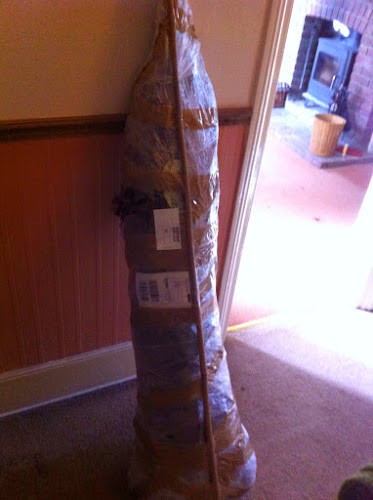As part of my agreement with the Woodland Trust, I am allowed to lose 20% of the trees I planted and if any more die, I must replace them. The Grand Tree Survey calculated a loss rate of just over 4% (64 trees) and as I had wanted to plant sweet chestnut and wild pear from the beginning, I decided to order enough to replace them.
Looking around, there are many nurseries that supply common trees like that but some of them had minimum order numbers and before I knew it, I'd ordered 137 trees!:
50 x sweet chestnut (sativa castanea)
25 x wild pear (pyrus communis)
25 x black locust (robinia pseudoacacia) - this is the first non-native I've ordered. With climate change ever present, not all of our Northern European species are going to survive. Ash is under threat and many other species are struggling too (sweet chestnut, poplar, larch etc.) so some hardy foreign species were proposed. Robinia is a nitrogen fixer, so doesn't mind poor soils, it grows quickly, coppices well, has beautiful blossom and produces some of the best firewood there is. The wood is also very rot resistant. It is quite thorny, though, so these will be planted around the boundaries
25 x black maul/almond willow (salix triandra) - the best weaving willow. We have plenty of osier (viminalis) but that's more suitable for structural work - fedges etc. We'd like to try weaving some baskets or decorations so although paying for willow went against my better nature, into the basket it goes!
10 x dogwood (cornus sanguinea) - there is a roundabout in a nearby town that has been planted with dogwood and the stems are amazing. It's also useful for weaving and will add a splash of winter colour!
1 x black mulberry (morus nigra) - a belated anniversary present for my wife. The 5 year anniversary is wood and I had promised to buy her a fruit tree
1 x almond (prunus dulcis) - I love almonds and this one promises to be a good nut producer. Impulse buy! The roots on this had been quite severely pruned - I hope it survives:
--o--
The trees duly arrived and it was a pleasure planting such small numbers, without having to lug tubes and stakes around. I had a supply of spirals for such an eventuality for the extra trees and they all went into the database. Bit disappointed that the dogwood weren't particularly red, but maybe they take a year or so to get going. I think they produce edible fruits eventually and some of them will help shield some fencing.
16/02/2015 - I was away from home, satisfied that all my trees were in the ground ready for spring. My wife texted to say "your trees have arrived and need paying for". After a brief discussion we discovered that one of the nurseries I'd initally made enquiries about (who couldn't supply the chestnut) had located some and delivered:
50 x sweet chestnut
10 x wild pear
10 x black locust
1 x black mulberry
I immediately contacted the nursery and after reaching an amicable agreement, once I got home again, I planted the extra trees. Losing them wasn't too difficult and for such a small number, it didn't take too long.
Behind our stables there is a patch of wasteland. A large leylandii tree fell down and shattered the fence and there are a few elder and privet trees there, indicating it's not brilliant land. Decided to start rebuilding the boundary with some of the black locust, which has been planted inside a dead hedge:
There's some way to go before it's completely dog proof but hopefully the spiky robinia will make it a secure hedge, if it can outcompete the willow which will probably start growing too. Getting the material to the site isn't easy and the ground is so full of rubble, old bits of fence wire and other rubbish, actually getting it in the ground is proving problematic.
Either by mistake or design, some of the nurseries had supplied more than the order (by one) so I eventually ended up with:
104 x sweet chestnut
38 x wild pear
36 x black locust
25 x black maul
11 x dogwood
2 x mulberry
At time of writing, there are 1,681 trees in my database - just hope I'm around to see them all grow! I haven't included most of the willow sets I stuck in the ground in various places. There are also hundreds of naturally seeded trees, mainly oaks, willow and birch which are excluded. The mature trees aren't currently recorded either but there's a future project.





